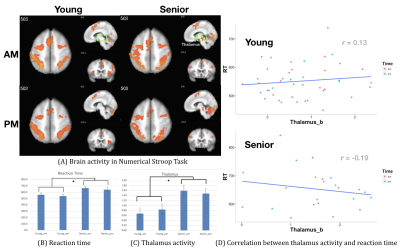3903
Compensatory Effect of Thalamus on Numerical Stroop Task in Senior Adults1Taipei Medical University, Taipei, Taiwan, 2Department of Psychology, National Chengchi University, Taipei, Taiwan, 3National Chiao Tung University, Hsinchu, Taiwan, 4Graduate Institute of Mind, Brain and Consciousness, Taipei Medical University, Taipei, Taiwan
Synopsis
To unveil the time-of-day effect in the aging process, we recruited both young and senior adults to participate fMRI experiments with the numerical Stroop task before and after nap. Beyond the dorsal attention network, we found the thalamus activity showed facilitating effect in the senior adults but the opposite way in the young adults. Such finding supports the compensation-related utilization of neural circuits hypothesis across age groups, but the time-of-day effect was relatively minor compared to the age effect.
Synopsis
To unveil the time-of-day effect in the aging process, we recruited both young and senior adults to participate fMRI experiments with the numerical Stroop task before and after nap. Beyond the dorsal attention network, we found the thalamus activity showed facilitating effect in the senior adults but the opposite way in the young adults. Such finding supports the compensation-related utilization of neural circuits hypothesis across age groups, but the time-of-day effect was relatively minor compared to the age effect.Introduction
Senior adults usually has difficulty to maintain attention persistently within a day.1 In other words, aging deteriorates the stability of the circadian rhythm, leading to poor sleep quality and poor cognitive functions. Recently, neuroimaging literature points out that the brain attention network in the elderly adults is more vulnerable to the circadian effect as compared to the young population,2 but the attention performances can benefit from an afternoon nap.3 However, such time-of-day effect in the aging process has yet been fully understood in the field of neuroimaging. Therefore, we evaluated the attention performances of the senior adults before and after a nap. We hypothesized a compensatory effect in the elderly brain to maintain the cognitive performance at different times of a day, as compared with the young population.Methods
We recruited 27 young (age:23.8±3.9) and 14 senior adults (age:66.4±5.2) to participate two fMRI sessions within a day: 10 am and 2pm, and they were asked to have a nap after lunch. In each fMRI session, the participant was asked to perform the numerical stroop task (NST),4 selecting between two numbers with larger magnitude, composed of six 36-sec blocks (2 congruent, two incongruent and two neutral). There are eighteen stimuli were presented in each block and the blocks appeared randomly. The task-based fMRI data and axial 3D T1-weighted were acquired at a 3T Skyra MRI at National Chengchi University using EPI sequence: TR/TE/FA=2000 ms/30 ms/90°, 33 slices with thickness of 3.4 mm, matrix size: 64×64, and FOV=240×240 mm2. After standard preprocessing, a general linear model was performed to calculate the brain activation map. Group-level analysis was performed by a 2x2 mixed-effect ANOVA (Age x Time). Multiple comparison was conducted by AFNI 3dClustSim with autocorrelation function adjustments.Results
Figure 1A shows the brain activation maps of NST, where the spatial extent of the activated areas seemed to be larger in the morning for both age groups. Interestingly, the thalamus activation of NST was found in the senior adults only. In Fig 1B, the reaction time showed significance in both age and time effects (p < .001). Figure 1C shows that the thalamus activity in the senior adults was stronger that in the young group (p < .001). At last, the scatter plot (Fig.1D) denotes that reaction time has slight positive correlation (r =.13) with thalamus activity in the young group, but the results in the senior adults showed a negative correlation (r =-.19) .Discussion and Conclusion
Compared to the young adults, senior adults had thalamus activation of the thalamus to improve task performances (reduced reaction time). Such finding may be interpreted as part of the CRUNCH model in the aging process, i.e., thalamus may serve as a compensation function in NST, especially in the senior adults. Nevertheless, though the two groups showed different trends of thalamus activity at different timing, both groups did not show the timing effect at the current stage. Further investigations with more sample size are required to further unveil the time-of-day effect in the aging process.Acknowledgements
This research was supported by Taiwan Ministry of Science and Technology (MOST 108-2321-B-038-005-MY2) and Taiwan National Health Research Institutes (NHRI-EX108-10829E1).References
1. Fortenbaugh FC, DeGutis J, Germine L, et al. Sustained attention across the lifespan in a sample of 10,000: Dissociating ability and strategy. Psychol Sci. 2015; 26(9): 1497–1510.
2. Anderson JAE, Campbell KL, Amer T, Grady CL, Hasher L. Timing is everything: Age differences in the cognitive control network are modulated by time of day. Psychol Aging. 2014;29(3):648-657.
3. Li J, Cacchione PZ, Hodgson N, et al. Afternoon napping and cognition in Chinese older adults: findings from the China Health and Retirement Longitudinal Study Baseline Assessment. J Am. Geriatr. Soc. 2017;65:373-380.
4. Huang CM, Polk TA, Goh JO, et al. Both left and right posterior parietal activations contribute to compensatory processes in normal aging. Neuropsychologia 2012; 50: 55-66.
